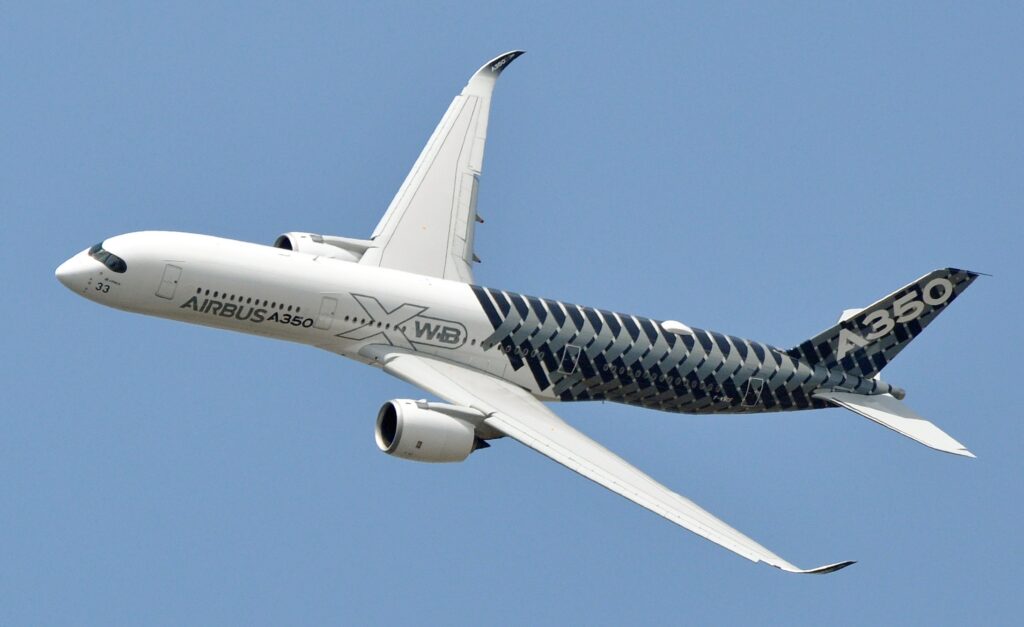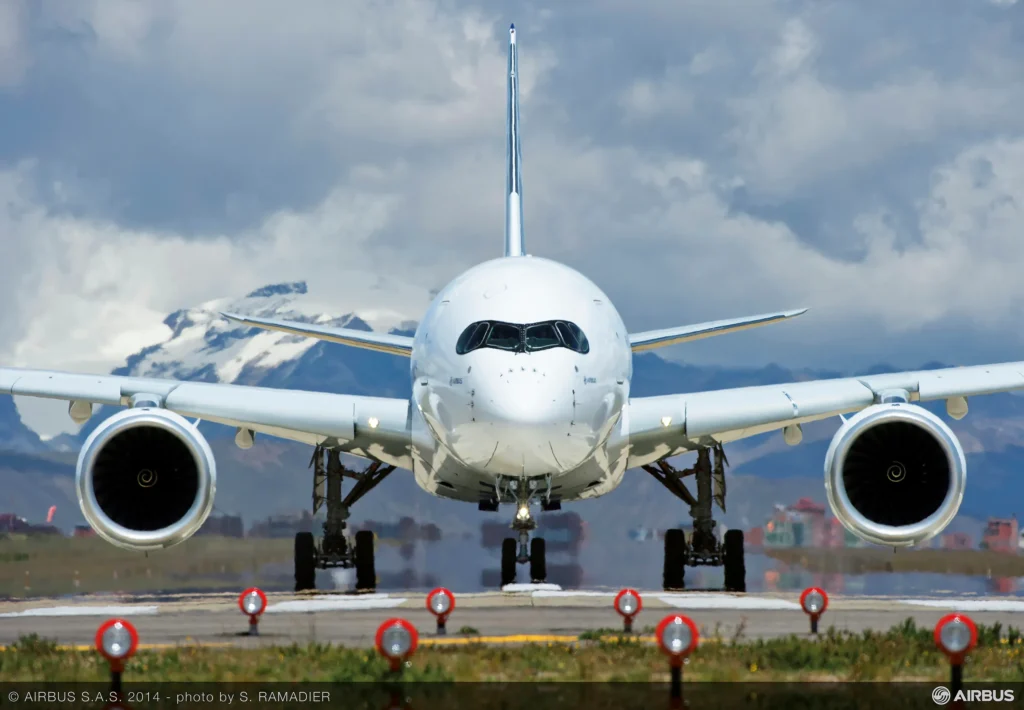
The Airbus A350 is one of the most technologically advanced and fuel-efficient aircraft flying today. As the aviation industry moves toward more sustainable and passenger-friendly solutions, the A350 serves as a blueprint for the future of long-haul air travel. Introduced to meet the growing demand for fuel-efficient wide-body jets, the A350 blends aerodynamic brilliance, cutting-edge materials, and unmatched cabin comfort into one impressive aircraft.
Since its first commercial flight in 2015, the A350 has become a favorite among global carriers like Qatar Airways, Singapore Airlines, and Lufthansa, offering both operational advantages and a superior flying experience.
1. Revolutionary Aerodynamics and Structural Design
The A350’s aerodynamic design is a standout feature that directly contributes to its performance and fuel efficiency.
Key Engineering Highlights:
- Curved Wingtips (Sharklets): These upward-swept tips reduce vortex drag, improving fuel efficiency and enhancing lift. Inspired by avian wing design, they also contribute to smoother takeoffs and landings.
- Carbon Fiber Reinforced Polymer (CFRP) Fuselage: Over 50% of the aircraft is made of composite materials, significantly lowering weight while increasing corrosion resistance and durability.
- Streamlined Nose and Body Shape: A smooth, rounded fuselage and low-drag design elements minimize air resistance, enhancing both speed and efficiency.
This design synergy allows the A350 to consume less fuel, carry more passengers or cargo, and fly longer distances—all while reducing wear on components.
2. Fuel Efficiency and Environmental Responsibility
Sustainability is at the core of the A350’s mission. It’s built to be a green aviation solution without compromising performance.
Eco-Friendly Engineering:
- Rolls-Royce Trent XWB Engines: Specifically developed for the A350, these twin engines offer 15% greater efficiency than their predecessors. They are currently among the most fuel-efficient large aero engines in operation.
- 25% Reduction in Carbon Emissions: On a per-seat basis, the A350 produces up to 25% fewer CO2 emissionsthan previous-generation aircraft, aligning with global sustainability goals.
- Noise Reduction Technology: With sound-absorbing linings and optimized engine nacelles, the A350 is one of the quietest long-haul aircraft, reducing noise pollution around airports.
These advancements make the A350 a strong choice for eco-conscious airlines looking to reduce their carbon footprint.
3. Cockpit Technology and Digital Intelligence
At the helm of the A350 is a digital flight deck that enhances safety, performance, and ease of control.
Technology That Pilots Love:
- Advanced Fly-by-Wire System: Electronically controlled flight surfaces ensure greater maneuverability, lower pilot workload, and smoother flight characteristics.
- Six Large LCD Displays: The cockpit features intuitive touchscreen systems and reconfigurable displays, improving situational awareness and information accessibility.
- Real-Time System Monitoring: The onboard Central Maintenance System constantly monitors aircraft performance, alerting ground teams to issues before they escalate.
These innovations make the A350 not only safer but also easier to maintain, reducing aircraft-on-ground (AOG) time and improving airline fleet reliability.
4. Passenger Comfort: A True Long-Haul Luxury Experience
Airbus has made passenger wellness and comfort a top priority in the A350’s cabin design.
Unrivaled Cabin Experience:
- Spacious Cabin Width (5.61 meters): Allows for wider economy seats and aisles, enhancing personal space and mobility during flight.
- Low Cabin Altitude (Equivalent to 6,000 ft): Combined with higher humidity levels (up to 25%), this reduces jet lag and improves passenger well-being.
- Ultra-Quiet Cabin: Advanced acoustic insulation and vibration dampening provide a serene, peaceful environment, even during cruise.
- LED Mood Lighting: Customizable lighting sequences help reduce fatigue and adjust passengers’ circadian rhythms, especially beneficial on ultra-long-haul flights.
Whether you’re flying in economy or first class, the A350 ensures a more relaxed and rejuvenating journey.

5. Impressive Long-Range Performance
One of the defining features of the A350 family is its ability to connect distant cities without refueling.
A350 Range Variants:
| Variant | Maximum Range (nm) | Typical Seating |
|---|---|---|
| A350-900 | 8,100 | 300–350 |
| A350-1000 | 8,700 | 350–410 |
These ranges enable airlines to operate non-stop flights on some of the longest routes in the world—such as Singapore to New York—without compromising comfort or payload.
6. Enhanced Cargo Capabilities
In the post-pandemic world, cargo revenue has become a critical factor for airlines. The A350 is ready for this new reality.
Cargo Highlights:
- Lower Deck Flexibility: The fuselage design allows for more efficient container loading, enabling better use of space for luggage and freight.
- Payload Versatility: The aircraft can simultaneously handle high passenger loads and significant cargo volumes, maximizing route profitability.
Additionally, Airbus has developed freighter variants of the A350 to meet the growing demand for air freight.
7. Airline Efficiency and Commercial Appeal
The A350 doesn’t just benefit passengers—it also delivers value where it matters most to airlines.
Operational Excellence:
- Lower Operating Costs: Thanks to fuel savings, advanced materials, and predictive maintenance tools, the A350 costs less to operate over time than most of its competitors.
- Fleet Commonality: Airbus designed the A350 to share cockpit similarities with other Airbus aircraft, reducing pilot training time and costs.
- High Dispatch Reliability: With over 99.3% dispatch reliability, the A350 ensures consistent performance for long-haul operations.
From ultra-long-haul connectivity to short runway adaptability, the A350 fits a wide range of airline business models.
Conclusion: Why the Airbus A350 Is the Future of Flight
The Airbus A350 is not just an aircraft—it’s a comprehensive solution to the challenges of modern air travel. Its balance of technological innovation, environmental consciousness, and passenger-centric design positions it as a leader in next-generation aviation.
For passengers, it means a smoother, quieter, and healthier flying experience. For airlines, it means lower costs, fewer emissions, and longer reach. In short, the A350 isn’t just a plane—it’s a promise of what aviation can and should be.

Leave a Reply